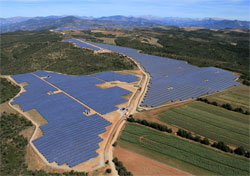Optimal planning of solar power plants

In the future, large PV plants such as the Siemens solar farm that went into operation in 2011 in Le Mées, France, can be planned quickly and effi ciently using the PVplanet software solution. © Siemens AG<br>
The share of renewable energies in the overall energy mix is rising rapidly worldwide. With three-fi gure growth rates, photovoltaics (PV) play a major role. According to market research organizations, the PV market grew by 139 percent in the year 2010. Germany is among the world‘s leaders in this technology that uses solar cells to convert sunlight straight into electrical energy.
Yet the task of planning large-scale PV power plants spanning several square kilometers is a complex one. With customer specifi cations, regulations and government subsidy programs to consider, designers must also account for numerous other factors including weather, climate, topography and location. These factors, in turn, infl uence the selection and placement of the individual components which include the PV arrays with their solar modules, inverters and wiring, not to mention access roads. Until now, engineers have designed solar power plants using CAD programs, with every layout and every variation painstakingly generated separately. This is a very time-consuming approach. To improve a planned power plant in terms of certain criteria, or to compare different concepts with one another, oftentimes the entire planning process has to be repeated.
Several hundred plant designs at the push of a button
In the future, this approach will be improved considerably: researchers at the Fraunhofer Institute for Industrial Mathematics ITWM in Kaiserslautern, in collaboration with Siemens Energy Photovoltaics, have developed a new planning software that makes it possible to build solar power plants better and more quickly. “Our algorithms programmed exclusively for the Siemens PVplanet (PV Plant Engineering Toolbox) software provide engineers with several hundred different plant designs in a single operation. It takes less than a minute of computation time,“ ITWM researcher Dr. Ingmar Schüle points out. The only user inputs are parameters such as the topography of the construction site and the module and inverter types that will be used. The user can also change a number of parameters – such as the orientation, spacing and inclination of the solar arrays – to study the impact on the quality of the planning result.
Cost estimates and income calculations included
To evaluate the designed PV power plants, an income calculation is performed that includes a simulation of the weather in the region in question, the course of the sun throughout the year and the physical module performance including shading effects. With the results of this computation and an estimate of the investment and operating costs, the planning tool can come up with a fi gure for the LCOE (levelized cost of energy).
By comparing the plant with a large number of similar confi gurations, the planners can investigate the sensitivity of the various parameters to fi nd the right solution from a large array of options. “The software assists the expert with decisionmaking and helps with the design of the best possible PV power plant for the site involved. Which one is ‘best‘ depends on a number of aspects – from the customer’s objectives to the site and environmental conditions, but also on the fi nancing concept and the fi nancial incentives for photovoltaics in the target region. All of these criteria are taken into account.“ Schüle points out. Dr. Martin Bischoff, project manager at Siemens AG, Energy Sector, is also convinced of this approach: “Aside savings, more than anything else the planning tool provides an overview of the scope for optimization.
This provides the best possible support for planning the most cost-effi cient systems. There has been no other planning software with this scope or level of detail until now.“ Interested individuals can get an impression of the successful teamwork between ITWM and Siemens Energy Photovoltaics at the Intersolar Europe trade fair in Munich, June 13-15, 2012: the software celebrates its public premiere at the Siemens booth in Hall B4, Booth B4.380.
Media Contact
All latest news from the category: Power and Electrical Engineering
This topic covers issues related to energy generation, conversion, transportation and consumption and how the industry is addressing the challenge of energy efficiency in general.
innovations-report provides in-depth and informative reports and articles on subjects ranging from wind energy, fuel cell technology, solar energy, geothermal energy, petroleum, gas, nuclear engineering, alternative energy and energy efficiency to fusion, hydrogen and superconductor technologies.
Newest articles

Recovering phosphorus from sewage sludge ash
Chemical and heat treatment of sewage sludge can recover phosphorus in a process that could help address the problem of diminishing supplies of phosphorus ores. Valuable supplies of phosphorus could…

Efficient, sustainable and cost-effective hybrid energy storage system for modern power grids
EU project HyFlow: Over three years of research, the consortium of the EU project HyFlow has successfully developed a highly efficient, sustainable, and cost-effective hybrid energy storage system (HESS) that…

After 25 years, researchers uncover genetic cause of rare neurological disease
Some families call it a trial of faith. Others just call it a curse. The progressive neurological disease known as spinocerebellar ataxia 4 (SCA4) is a rare condition, but its…





















